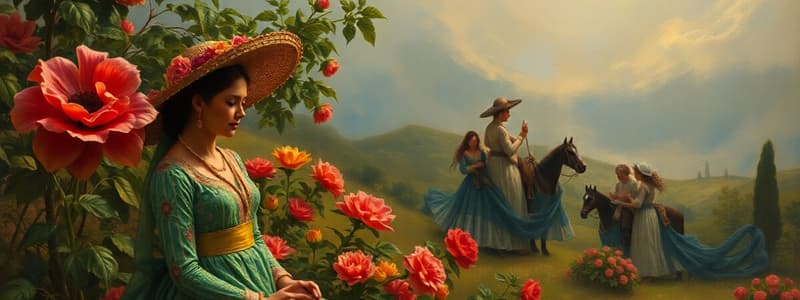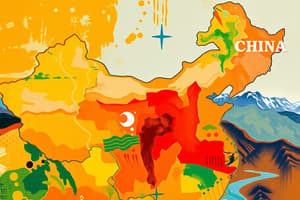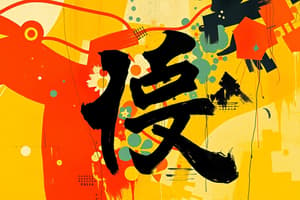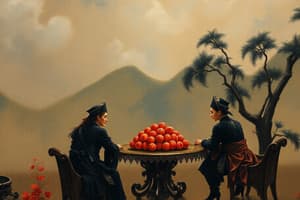Podcast
Questions and Answers
Analyze the socio-political factors that allowed for the abduction and enslavement of individuals like Mirra during the 17th century.
Analyze the socio-political factors that allowed for the abduction and enslavement of individuals like Mirra during the 17th century.
Volatile political climates, piracy, and the Trans-Pacific slave trade.
How did the Spanish colonial authorities categorize individuals from diverse Asian backgrounds, and what impact did this categorization have on their identities?
How did the Spanish colonial authorities categorize individuals from diverse Asian backgrounds, and what impact did this categorization have on their identities?
They categorized them as 'Chinos,' which erased their distinct ethnic origins.
Evaluate the role of the Catholic Church in shaping the legacy of Catarina de San Juan, and explain how her story served the Church's objectives in colonial Mexico.
Evaluate the role of the Catholic Church in shaping the legacy of Catarina de San Juan, and explain how her story served the Church's objectives in colonial Mexico.
The Church promoted her as an exemplary figure of religious devotion to inspire women.
Critique the claim that the China Poblana costume directly originated from the clothing Catarina de San Juan brought from India, considering alternative perspectives and historical evidence.
Critique the claim that the China Poblana costume directly originated from the clothing Catarina de San Juan brought from India, considering alternative perspectives and historical evidence.
Assess the significance of the legend of Catarina de San Juan in the context of Mexican national identity, and discuss the implications of portraying a historical figure as a symbol of modern Mexican womanhood.
Assess the significance of the legend of Catarina de San Juan in the context of Mexican national identity, and discuss the implications of portraying a historical figure as a symbol of modern Mexican womanhood.
Speculate on the possible reasons why Catarina de San Juan's Indian origins were obscured over time in favor of the 'China Poblana' identity.
Speculate on the possible reasons why Catarina de San Juan's Indian origins were obscured over time in favor of the 'China Poblana' identity.
How did the Battle of Suvali contribute to the changing geopolitical landscape of 17th century India?
How did the Battle of Suvali contribute to the changing geopolitical landscape of 17th century India?
What role did cities like Surat and Manila play in the Trans-Pacific exchange of goods, culture, and people during the 17th century?
What role did cities like Surat and Manila play in the Trans-Pacific exchange of goods, culture, and people during the 17th century?
How did the image of Catarina de San Juan evolve from a modestly dressed slave to the iconic figure associated with the vibrant China Poblana costume?
How did the image of Catarina de San Juan evolve from a modestly dressed slave to the iconic figure associated with the vibrant China Poblana costume?
In what ways did the legend of Catarina de San Juan reflect the syncretism (blending) of different cultural elements in colonial Mexico?
In what ways did the legend of Catarina de San Juan reflect the syncretism (blending) of different cultural elements in colonial Mexico?
Examine the historical evidence that supports or contradicts the claim that Catarina de San Juan significantly influenced the design or adoption of the China Poblana costume.
Examine the historical evidence that supports or contradicts the claim that Catarina de San Juan significantly influenced the design or adoption of the China Poblana costume.
How did the social hierarchy of colonial Mexico, particularly the classification of individuals as 'Chinos,' impact Catarina de San Juan's life and identity?
How did the social hierarchy of colonial Mexico, particularly the classification of individuals as 'Chinos,' impact Catarina de San Juan's life and identity?
Discuss how the legend of Catarina de San Juan has been used to promote specific cultural and religious values in Mexico.
Discuss how the legend of Catarina de San Juan has been used to promote specific cultural and religious values in Mexico.
Analyze the economic factors that contributed to the Trans-Pacific slave trade and the demand for Asian slaves in New Spain.
Analyze the economic factors that contributed to the Trans-Pacific slave trade and the demand for Asian slaves in New Spain.
In what ways did the geographical locations of Surat, Cochin, Manila, and Acapulco influence the trajectory of Catarina de San Juan's life?
In what ways did the geographical locations of Surat, Cochin, Manila, and Acapulco influence the trajectory of Catarina de San Juan's life?
How did the religious conversion of Mirra to Catarina de San Juan alter her social status and opportunities in colonial Mexico?
How did the religious conversion of Mirra to Catarina de San Juan alter her social status and opportunities in colonial Mexico?
What specific aspects of Mughal Indian culture might have been retained by Catarina de San Juan, and how could these have influenced her actions or beliefs in Mexico?
What specific aspects of Mughal Indian culture might have been retained by Catarina de San Juan, and how could these have influenced her actions or beliefs in Mexico?
How did the political and economic interests of European powers, such as Portugal and Spain, shape the life of Catarina de San Juan?
How did the political and economic interests of European powers, such as Portugal and Spain, shape the life of Catarina de San Juan?
In what ways does the story of Catarina de San Juan challenge or reinforce common narratives about slavery and cultural exchange in the colonial era?
In what ways does the story of Catarina de San Juan challenge or reinforce common narratives about slavery and cultural exchange in the colonial era?
Discuss the ethical implications of using a historical figure's image to promote national identity, particularly when the historical figure's life was marked by trauma and exploitation.
Discuss the ethical implications of using a historical figure's image to promote national identity, particularly when the historical figure's life was marked by trauma and exploitation.
Given the context of the Trans-Pacific slave trade, what were some of the common experiences shared by Asian slaves arriving in New Spain during the 17th century?
Given the context of the Trans-Pacific slave trade, what were some of the common experiences shared by Asian slaves arriving in New Spain during the 17th century?
What were the motivations of the Portuguese Jesuits in baptizing Mirra and renaming her Catarina de San Juan?
What were the motivations of the Portuguese Jesuits in baptizing Mirra and renaming her Catarina de San Juan?
How did the Spanish merchant's purchase of Catarina from a Manila auction contribute to her journey and eventual transformation into a cultural icon?
How did the Spanish merchant's purchase of Catarina from a Manila auction contribute to her journey and eventual transformation into a cultural icon?
How might Catarina's early life in Mughal India have shaped her resilience and adaptability in the face of enslavement and cultural displacement?
How might Catarina's early life in Mughal India have shaped her resilience and adaptability in the face of enslavement and cultural displacement?
What role did Father Pedro Suárez play in Catarina's life, and how did his actions influence her spiritual journey and subsequent recognition?
What role did Father Pedro Suárez play in Catarina's life, and how did his actions influence her spiritual journey and subsequent recognition?
How did Catarina's visions and prophecies contribute to her reputation and influence within the colonial society of Puebla?
How did Catarina's visions and prophecies contribute to her reputation and influence within the colonial society of Puebla?
Discuss the implications of commemorating Catarina de San Juan with a hotel and a ceramic plaque describing her as the 'enchanting princess of the Great Mughal.'
Discuss the implications of commemorating Catarina de San Juan with a hotel and a ceramic plaque describing her as the 'enchanting princess of the Great Mughal.'
What are some of the possible explanations for the gap between the modest attire Catarina was known for and the elaborate China Poblana costume associated with her legend?
What are some of the possible explanations for the gap between the modest attire Catarina was known for and the elaborate China Poblana costume associated with her legend?
Analyze the socio-economic conditions in 17th-century Puebla that allowed for Catarina de San Juan to become a figure of religious prominence and influence.
Analyze the socio-economic conditions in 17th-century Puebla that allowed for Catarina de San Juan to become a figure of religious prominence and influence.
In what ways did the hagiographies written about Catarina de San Juan shape her image and legacy for future generations?
In what ways did the hagiographies written about Catarina de San Juan shape her image and legacy for future generations?
How does the legend of Catarina de San Juan reflect broader themes of cultural appropriation and the representation of marginalized communities in popular culture?
How does the legend of Catarina de San Juan reflect broader themes of cultural appropriation and the representation of marginalized communities in popular culture?
What were some of the lasting impacts of the Trans-Pacific slave trade on the cultural landscape of Mexico?
What were some of the lasting impacts of the Trans-Pacific slave trade on the cultural landscape of Mexico?
How might contemporary discussions about identity and representation inform our understanding of the legend of Catarina de San Juan?
How might contemporary discussions about identity and representation inform our understanding of the legend of Catarina de San Juan?
In what ways did the society around Surat influence Catarina’s abduction and enslavement?
In what ways did the society around Surat influence Catarina’s abduction and enslavement?
Analyze how the traditional attire in the region of Puebla, known as the China Poblana, embodies cultural heritage and identity.
Analyze how the traditional attire in the region of Puebla, known as the China Poblana, embodies cultural heritage and identity.
How did the interactions between the Mughal Empire and European traders impact the course of Catarina's life?
How did the interactions between the Mughal Empire and European traders impact the course of Catarina's life?
What aspects of Mexico's colonial history are illuminated through the story of Catarina de San Juan?
What aspects of Mexico's colonial history are illuminated through the story of Catarina de San Juan?
In what ways do historical analyses offer diverse perspectives on the origin and authenticity of cultural symbols like the China Poblana costume?
In what ways do historical analyses offer diverse perspectives on the origin and authenticity of cultural symbols like the China Poblana costume?
The legend of Catarina de San Juan reflects societal and cultural dynamics in 17th century Mexico. Elaborate.
The legend of Catarina de San Juan reflects societal and cultural dynamics in 17th century Mexico. Elaborate.
Flashcards
Cinco de Mayo
Cinco de Mayo
A Mexican celebration on May 5th, honoring the victory over the French Empire at the Battle of Puebla in 1862.
China Poblana
China Poblana
Traditional attire for urban Mexican women of the Puebla region, often worn during Cinco de Mayo.
Catarina de San Juan
Catarina de San Juan
A 17th-century religious woman whose legend is linked to the origin of the China Poblana costume.
Mirra
Mirra
Signup and view all the flashcards
Surat
Surat
Signup and view all the flashcards
Portuguese buccaneers
Portuguese buccaneers
Signup and view all the flashcards
Baptism in Cochin
Baptism in Cochin
Signup and view all the flashcards
Manila
Manila
Signup and view all the flashcards
Manila Galleon
Manila Galleon
Signup and view all the flashcards
Acapulco
Acapulco
Signup and view all the flashcards
Puebla
Puebla
Signup and view all the flashcards
"Chinos"
"Chinos"
Signup and view all the flashcards
Father Pedro Suárez
Father Pedro Suárez
Signup and view all the flashcards
Domingo
Domingo
Signup and view all the flashcards
Hagiographies
Hagiographies
Signup and view all the flashcards
Study Notes
- Mexican art and culture has a deep-rooted connection with symbolism, cult, and history.
- The bright colors, patterns, and textures are often inspired by Mayan and Aztec religious, social, and cultural rituals.
- Cinco de Mayo is a Mexican celebration on May 5, honoring the Mexican Army’s victory over the French Empire at the Battle of Puebla in 1862.
- Women dance in vibrant costumes, including embroidered blouses, floral skirts, and rebozo shawls.
- This attire is known as China Poblana and is traditional for urban Mexican women of the Puebla region.
- The origin of China Poblana is linked to the legend of Catarina de San Juan, a 17th-century religious woman from Puebla.
- The story connects to a noble Mughal family from India and her journey to becoming a cultural icon in Mexico.
Catarina de San Juan
- Born around 1606 in India during the Mughal regime, possibly in a north Indian city.
- She was born into a Muslim family and named Mirra.
- Mirra's family emigrated to Surat to evade a Turkish invasion.
- Surat was a center of trade and faced socio-political challenges due to European interests.
- Portuguese buccaneers abducted Mirra from a beach near Surat when she was 10.
- She was taken to Cochin and baptized by Portuguese Jesuits as Catarina de San Juan.
- Catarina was transported to Manila through the Bay of Bengal.
Slave Trade
- Manila was the hub of the Trans-Pacific slave trade, supplying Asian slaves to Spanish America and New Spain.
- Slaves were transported to Acapulco in Mexico via the Manila Galleon and sold.
- Catarina was purchased by a Spanish merchant and arrived in Acapulco in 1619.
- She traveled to Puebla around 1621 and became a housemaid for Miguel de Sosa and his wife.
- Asian slaves in Mexico were categorized as "Chinos," regardless of their origin.
- Catarina was also labeled as a Chino, and her Indian roots faded.
Life in Mexico
- She became an efficient domestic helper and, after Miguel’s death, was freed.
- Catarina assisted Father Pedro Suárez in church proceedings.
- Father Suárez arranged her marriage to Domingo, another servant of Asian origin.
- She became a prominent religious figure after a vision advised her to remain chaste.
- She devoted her life to the Church after Domingo’s death.
- Catarina was known for her visions and prophecies and predicted the deaths of prominent figures.
- She worked for the needy and gained public recognition.
- Her popularity inspired texts, paintings, music, and Hispanic Baroque art.
- After her death, she was transformed into a saintly figure and remembered as China Poblana.
- A hotel commemorates her life with a plaque and statue in China Poblana costume.
Legacy
- The legend of Catarina de San Juan is credited with the origin of the China Poblana costume.
- Some believe the fashion originated from Indian fabrics brought by Catarina.
- Scholars debate the connection between the costume and the 17th-century Indian slave.
- The church promoted her as an exemplary figure of religious devotion.
- Hagiographies were written detailing her life, religious cult, and devotion to the church.
- The connection between Catarina de San Juan, China Poblana, and the costume is still debated.
- Her story has survived for centuries and is associated with modern Mexican womanhood.
- Mirra's life, from Mughal royalty to Mexican slave and saint, remains a notable folklore.
Studying That Suits You
Use AI to generate personalized quizzes and flashcards to suit your learning preferences.




